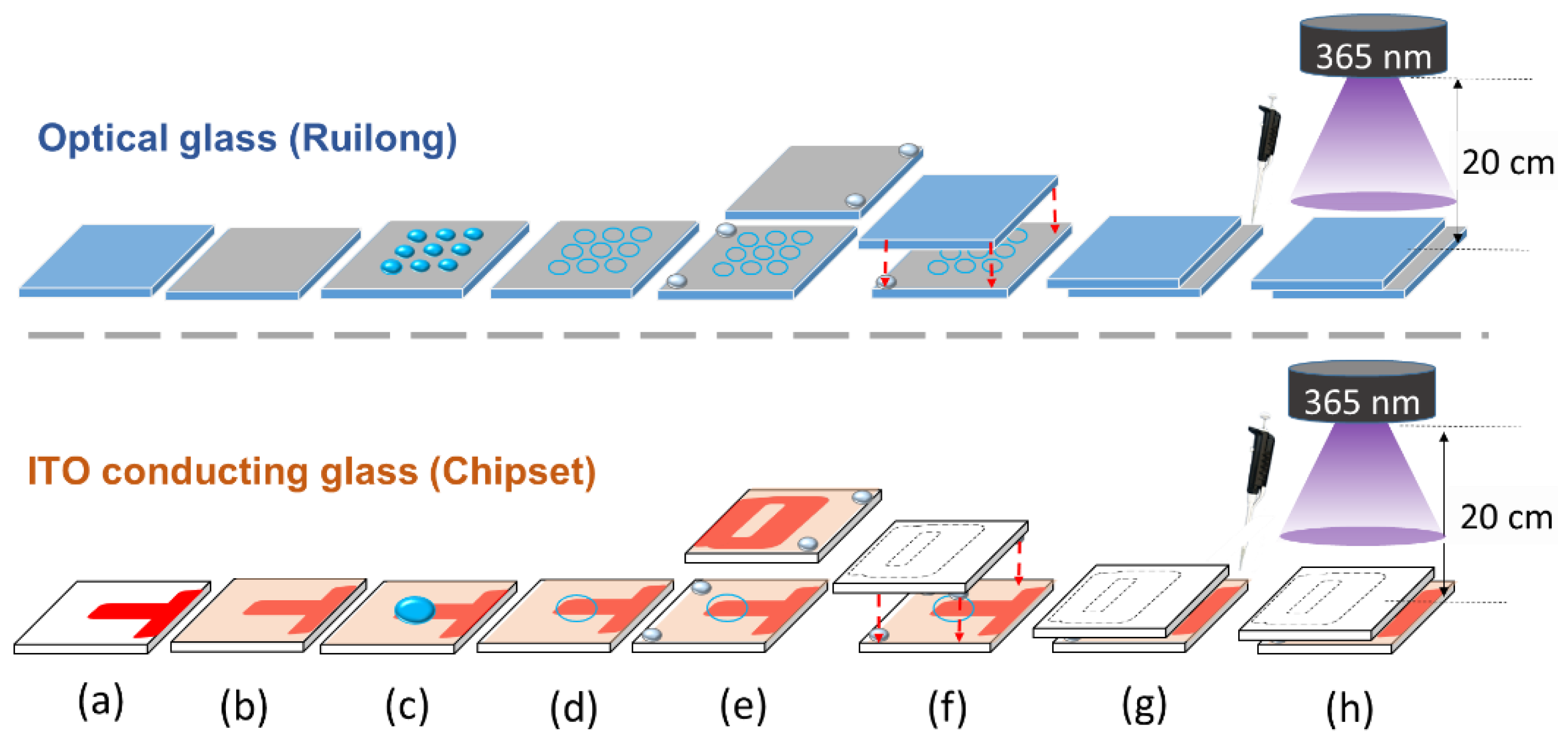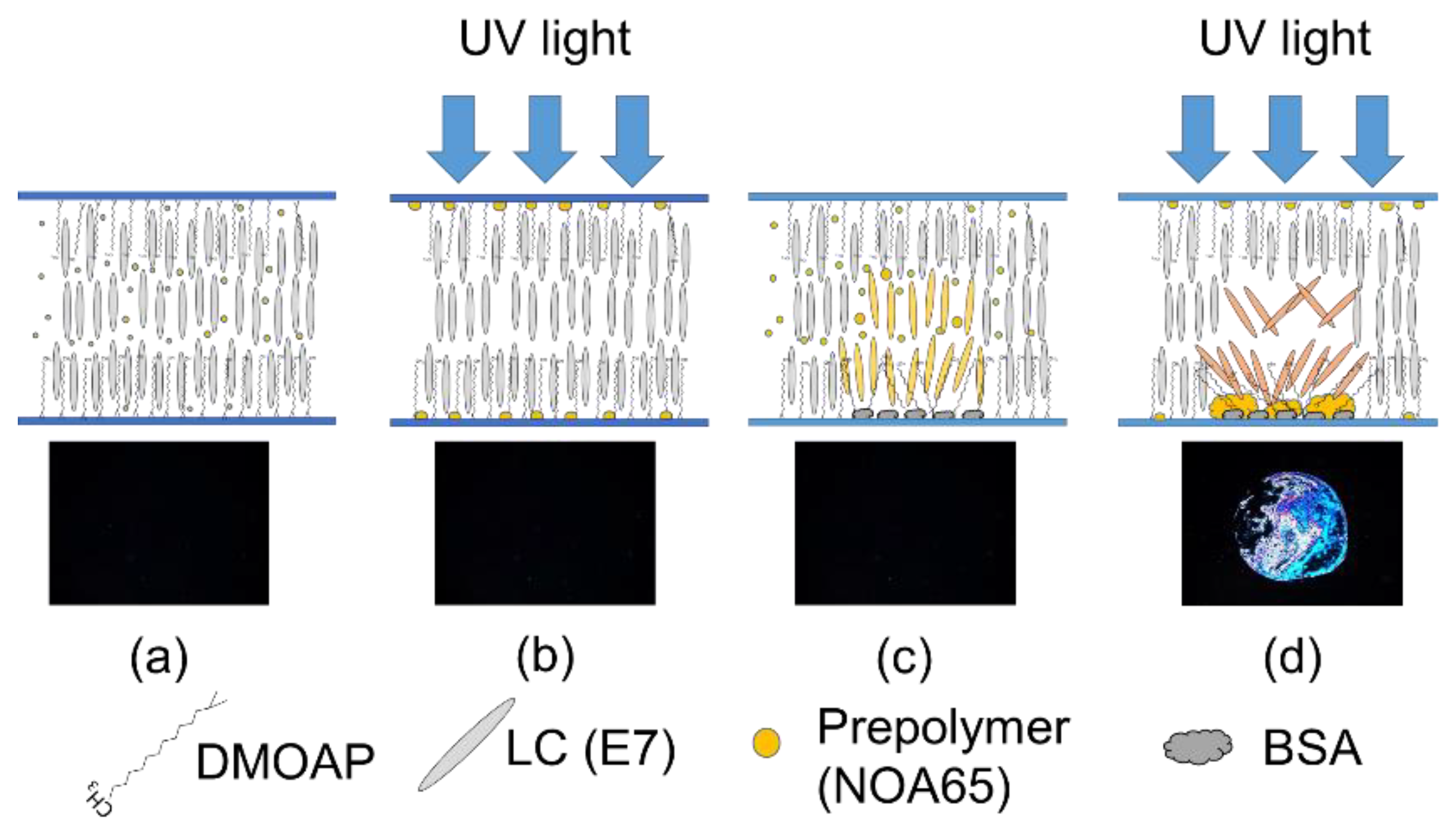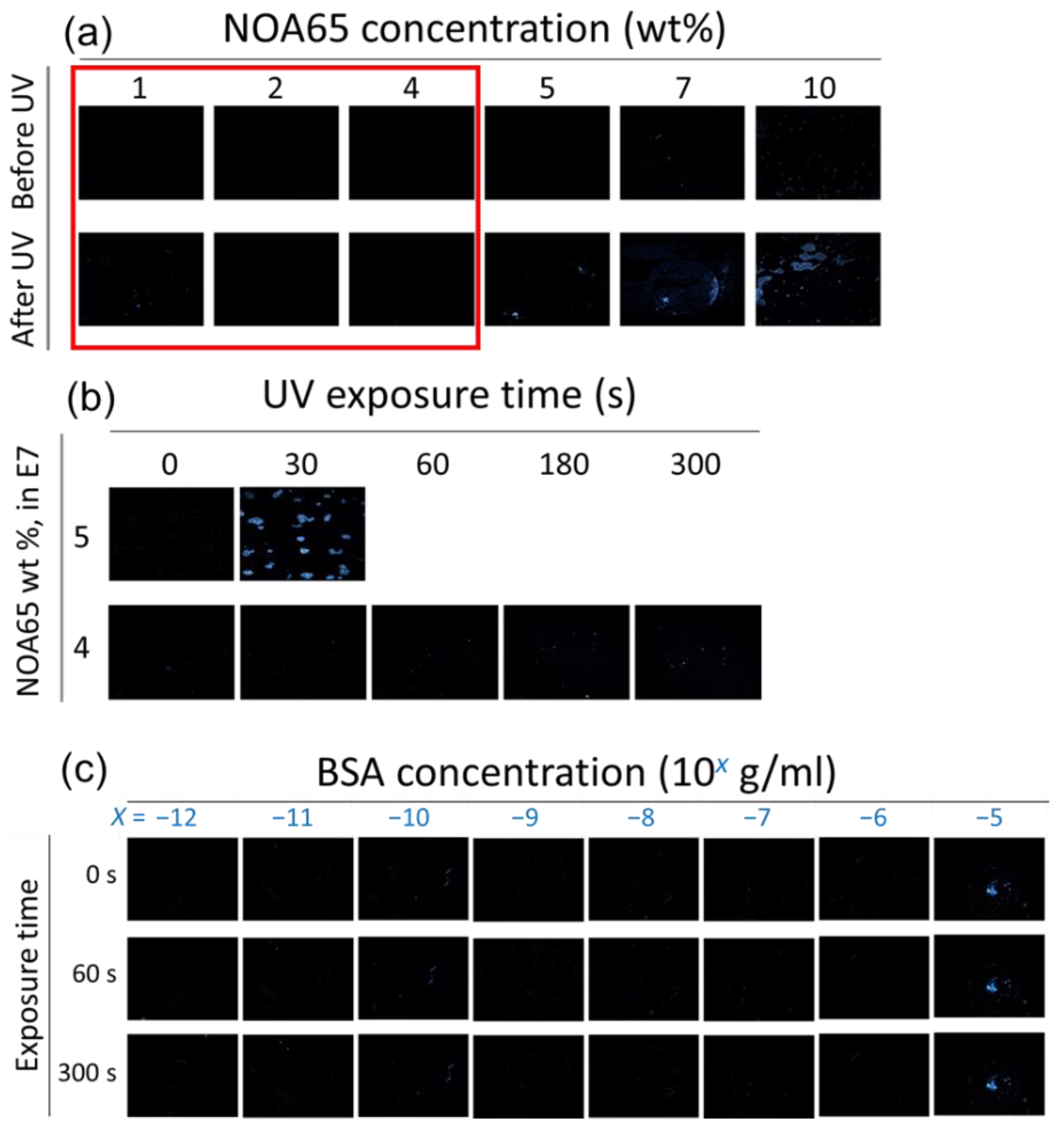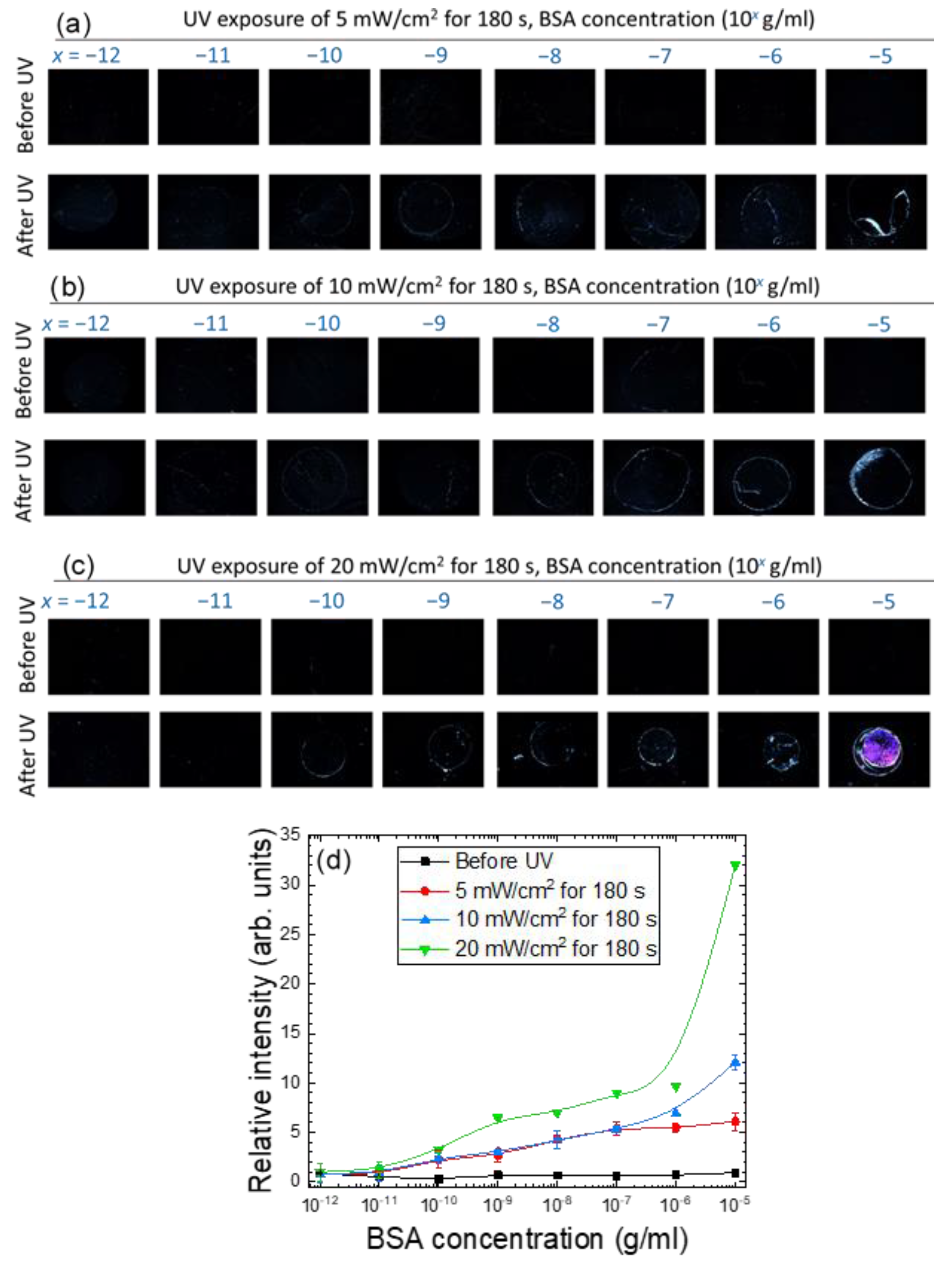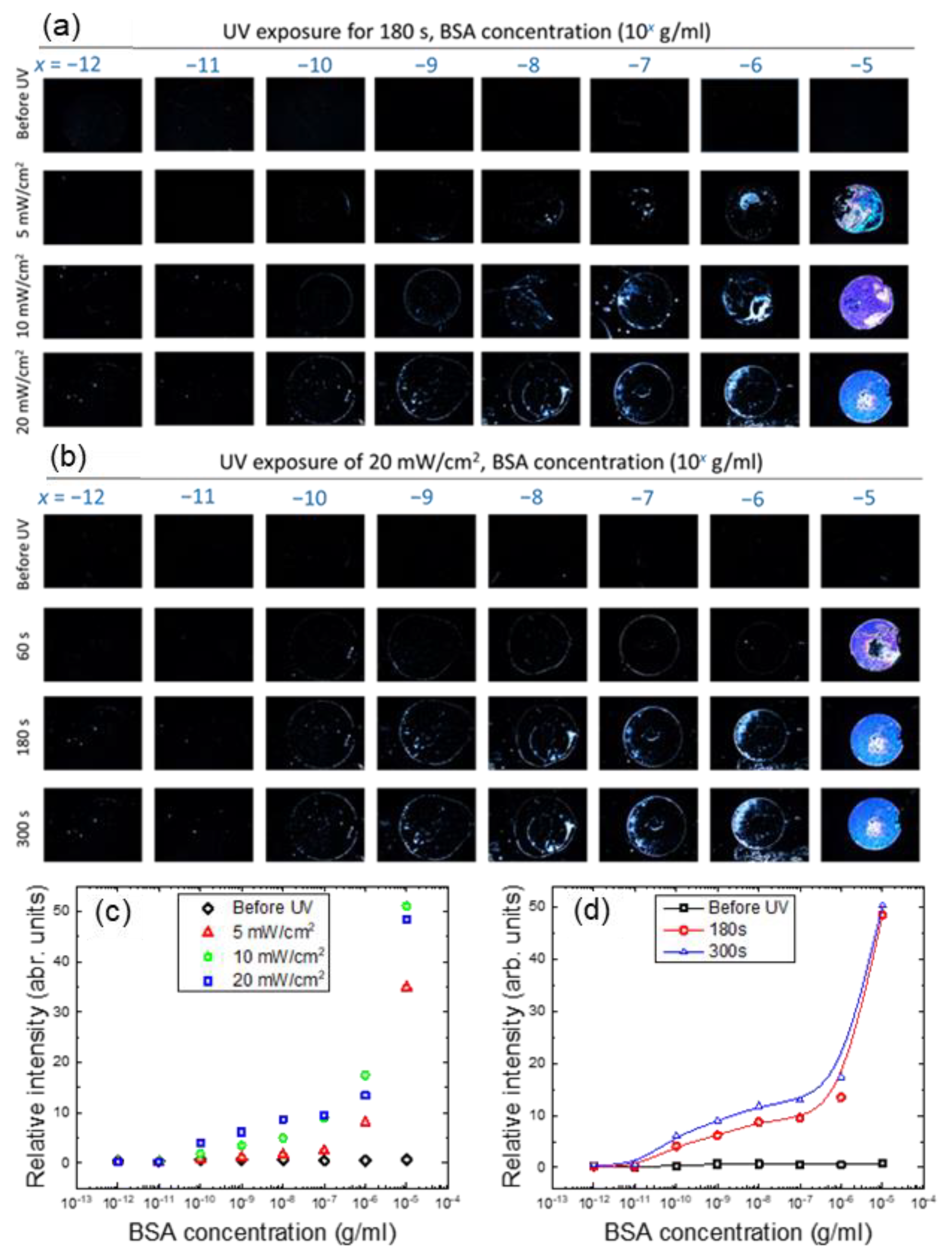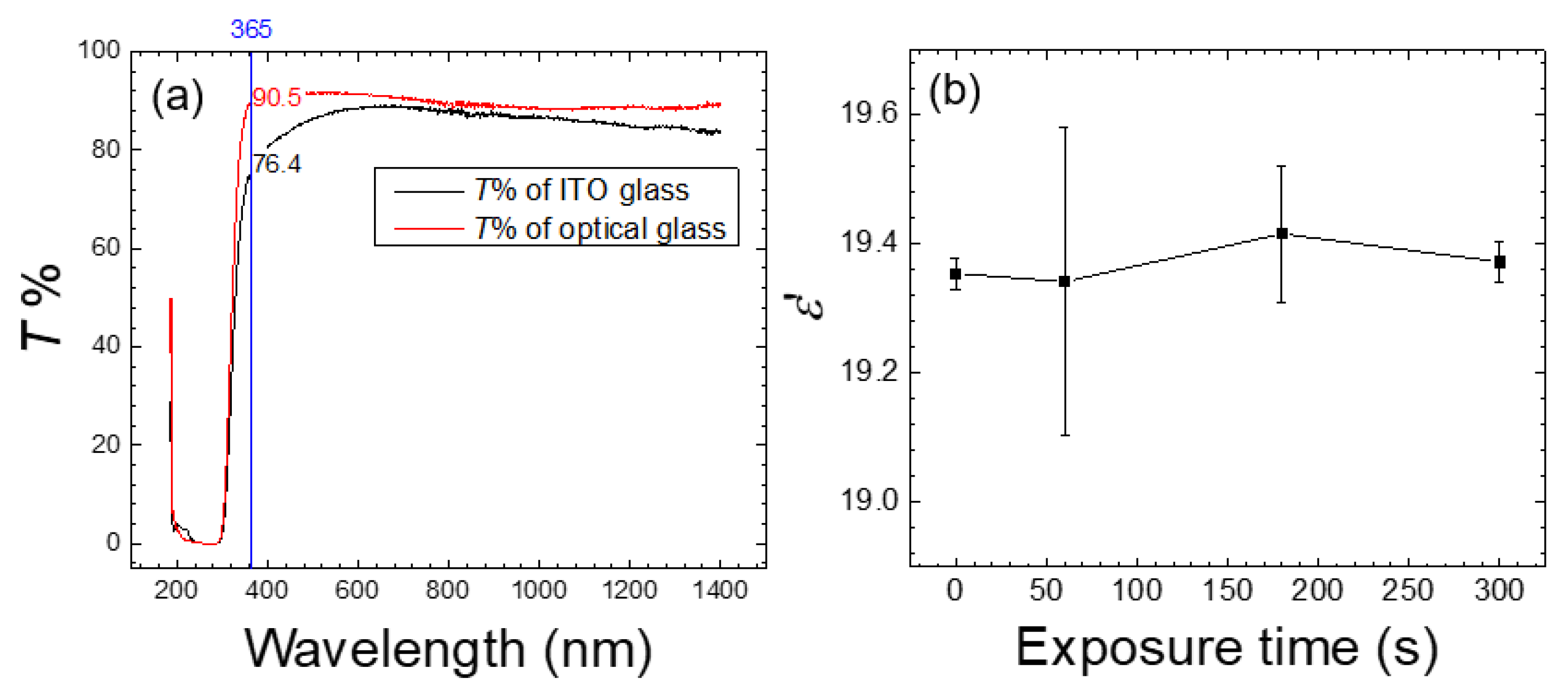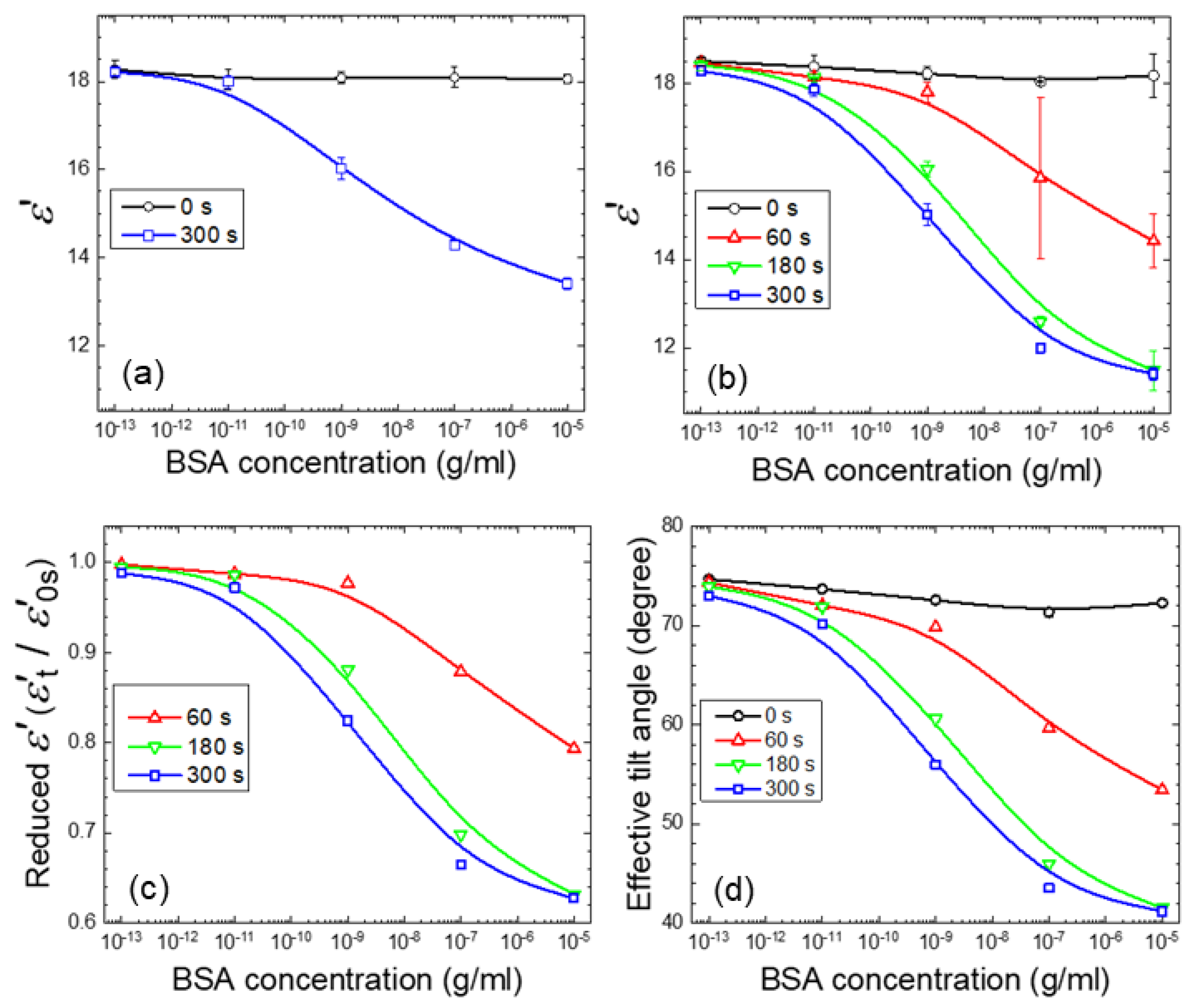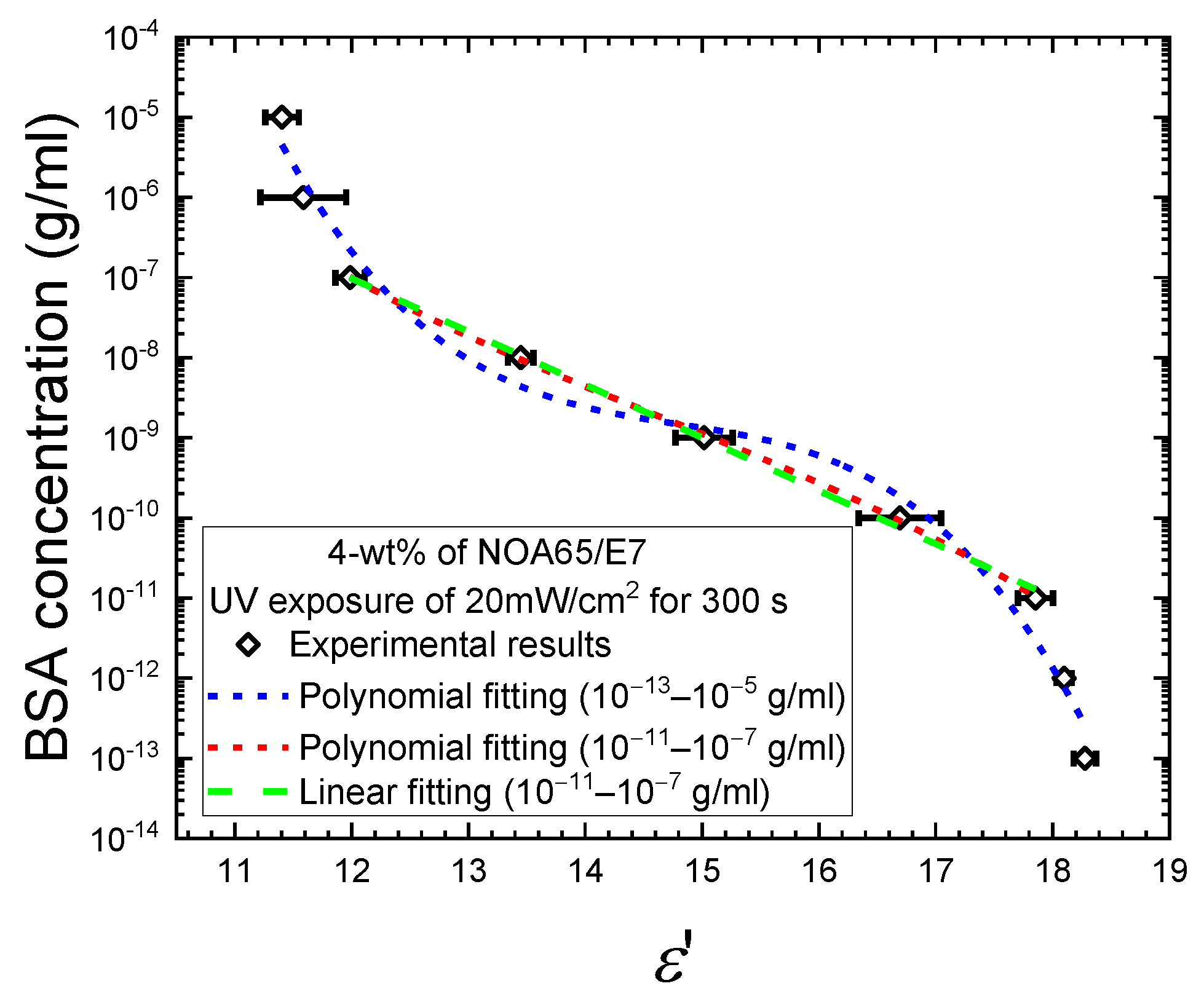3.1. Biosensing Based on the Optical Measurement of the LC–Photopolymer Composite
LC-based biosensing is facilitated by the interaction between biomolecules and LCs, whose orientation responds sensitively to the disturbance caused by the analyte, thereby generating optical and electro-optical signals that are proportional to the amount of biomolecules. The LC molecules are aligned homeotropically on a substrate coated with a vertical alignment film (DMOAP), giving rise to a dark state when observed under the POM. When biomolecules (BSA) were immobilized on the DMOAP-coated substrate, the vertical anchoring energy of DMOAP was weakened so that the LC molecules were more inclined to arrange randomly, resulting in light leakage and a dark-to-bright transition in the optical texture. In general, an enhanced optical response is considered to be correlated to an increase in the amount of the analyte located at the LC-glass interface. To improve the sensitivity and limit of detection, a photo-curable prepolymer NOA65 was added to the nematic E7 in this study to further amplify the optical signal.
As shown in
Figure 2a, in the absence of analytes the vertical anchoring strength of DMOAP was unaffected when a minute concentration of the NOA65 prepolymer was dispersed in E7. After UV exposure, the NOA65 prepolymer phase-separated and aggregated as small polymer gravels on the glass substrate due to the difference in surface tension between NOA65 and E7 [
25,
26], but the tilt angle of LCs remained unchanged (
Figure 2b). In the presence of a trace number of biomolecules, the orientation of LCs was slightly disturbed and the alignment effect of DMOAP was masked by the analyte, but because of the strong vertical anchoring exerted by DMOAP from both glass substrates, optical signals derived from light leakage was undetectable (
Figure 2c). Nevertheless, when photopolymerization of NOA65 was induced by UV exposure, surface roughness on the glass substrate was higher in the area with the immobilized biomolecules than that with DMOAP modification only, leading to greater disruption in LC orientation and, in turn, an enhanced optical signal (
Figure 2d). It is assumed that the ionic and polar side chains of amino acids distributed on the surface of a protein analyte (BSA in this study) attracted the relatively hydrophilic NOA65, which coalesced around BSA while being repelled by the hydrophobic alkyl chain of DMOAP, bringing about the difference in surface roughness in a situation similar to the preparation of self-positioning NOA65 micro lens [
28]. In addition, light scattering can be attributed to refractive-index mismatch in the multi-regional boundaries between the LC molecules, photopolymerized NOA65, DMOAP, BSA, and the glass substrate. As a consequence, LC molecules in the proximity of BSA were disturbed to a greater extent compared with those in direct contact with DMOAP, contributing to signal amplification of BSA without simultaneously increasing the background.
3.1.1. Experimental Conditions for the Preparation of the LC–Photopolymer Composite
To avoid false-positive optical signals, the extent of photopolymerization of NOA65 was carefully controlled so that in the absence of BSA the LC molecules remained vertically anchored and a dark background was observed for the LC–photopolymer composite under the POM with crossed polarizers. As a protein-free reference, DI water instead of BSA was used as the sample, which was dispensed and dried on the glass substrate, followed by LC cell assembly and interaction with the mixture of E7 and NOA65, as described in
Section 2.3 and
Figure 1. As shown in the upper panels of
Figure 3a, when E7 was doped with 1, 2, 4, 5, 7 or 10 wt.% of NOA65, the optical texture of the NOA65/E7 mixture remained dark. After irradiated with UV at 10 mW/cm
2 for 30 s, light leakage was observed at 5-, 7- and 10-wt.% NOA65 (lower panels,
Figure 3a). NOA65 concentration was thus maintained at 4 wt.% or lower in the following studies to avoid such nonspecific background noise. We then increased the UV intensity to 20 mW/cm
2 and prolonged the exposure time to 300 s for E7 doped with 4 or 5 wt.% of NOA65 (
Figure 3b). A pronounced light leakage was detected when the NOA65/E7 mixture containing 5-wt.% NOA65 was irradiated with UV for 30 s, whereas at 4 wt.% NOA65 the optical texture was completely dark up to a UV exposure time of 300 s. It can be concluded from the above results that in the absence of analytes at the LC-glass interface, LCs remained homeotropically aligned when NOA65 of concentrations ≤4 wt.% was exposed to a UV irradiance of no more than 20 mW/cm
2 for a period of time ≤300 s.
3.1.2. Protein Detection and Quantitation with the LC–Photopolymer Composite
To demonstrate signal amplification by photopolymerized NOA65, detection of BSA with pristine E7 as well as the NOA65/E7 composite was compared. As shown in
Figure 3c, LC cells were assembled with immobilized BSA in the concentration range of 10
−12 to 10
−5 g/mL on one of the DMOAP-coated glass substrates, followed by injection of only E7 and UV irradiation at 20 mW/cm
2 for 0, 60 or 300 s. Without NOA65 the lowest BSA concentration that can be discerned was 10
−5 g/mL from the optical texture of E7 under the POM. The optical signal at each BSA concentration remained unchanged when irradiated with UV for 60 or 300 s, suggesting that exposure to UV had no effect on the orientation of E7 itself. On the other hand, when doped with 1-wt.% NOA65, the optical texture of the NOA65/E7 mixture in the presence of BSA before UV irradiation was completely dark, similar to that of pristine E7 (
Figure 3c). When the LC cell was exposed to UV for 180 s at an intensity of 5, 10 or 20 mW/cm
2, optical signals can be observed at BSA concentrations lower than 10
−5 g/mL, and the brightness of the optical texture increased with increasing amount of BSA as well as UV intensity (
Figure 4a–c), suggesting that the increase in surface roughness caused by photopolymerization of NOA65, as explained in
Figure 2, was responsible for the enhanced light leakage and amplified optical signal. In order to quantitatively analyze the optical signal in relation to BSA concentration, the freeware ImageJ was used to perform image analysis and calculate the relative brightness of the optical texture. Results from the quantitative analysis, presented as a plot of relative intensity versus BSA concentration in
Figure 4d, was consistent with the texture observations (
Figure 4a–c). It was found that the higher the BSA concentration, the greater the enhancement in the texture brightness of the NOA65/E7 composite with UV intensities. When exposed to 20-mW/cm
2 UV, the texture brightness of the NOA65/E7 composite was significantly higher than that exposed to 5- or 10-mW/cm
2 UV in the higher BSA concentration range of 10
−10–10
−5 g/mL, but not at the lower 10
−12 and 10
−11 g/mL BSA concentrations. The limit of detection (LOD) was calculated according to the following equation:
where
s represents the standard deviation of the relative intensity (texture brightness) at the lowest BSA concentration, with its value significantly higher than that at 0-g/mL BSA, and
m represents the slope of the linear regression [
29]. Based on the results in
Figure 4d, the LOD values thus obtained were 1.0 × 10
−8, 8.8 × 10
−8 and 6.1 × 10
−9 g/mL BSA, when the NOA65/E7 mixture was exposed to UV irradiation of 5, 10 and 20 mW/cm
2, respectively. The calculated LOD was consistent with the BSA concentration at which the dark-to-bright transition was observed in
Figure 4a–c.
We next increased the doping concentration of NOA65 to 4 wt.%, the maximal concentration at which the homeotropic alignment of E7 can still be maintained without being significantly interfered by the photopolymerized NOA65 (
Figure 3). The NOA65/E7 mixture was exposed to UV at an irradiance of 5, 10 or 20 mW/cm
2 for 180 s (
Figure 5a) or for 60, 180 or 300 s at a fixed UV irradiance of 20 mW/cm
2 (
Figure 5b). As expected, the relative intensity of the optical texture of the NOA65/E7 composite increased with increasing BSA concentration, and was further enhanced by increasing UV irradiance and exposure time, except for those at 10
−5-g/mL BSA, where the brightness of the optical texture seemed to reach saturation and no longer correlated to UV irradiance (
Figure 5c,d). The LOD values for the detection by E7 doped with 4 wt.% NOA65 and exposed to UV at 20 mW/cm
2 for 180 and 300 s were 4.3 × 10
−8 and 3.4 × 10
−9 g/mL BSA, respectively. Compared with 1-wt.% NOA65, the optical signal was significantly amplified by doping E7 with 4-wt.% NOA65, especially at higher concentrations (10
−8 to 10
−5 g/mL) of BSA (compare
Figure 4d and
Figure 5c). However, at a fixed NOA65 concentration, increasing UV irradiance or prolonging UV exposure rendered relatively limited signal amplification (
Figure 4d and
Figure 5c,d).
In one of our previous studies, a single-substrate biodetection platform was constructed by spin-coating a thin layer of the NOA65/E7 composite film on a DMOAP-modified glass substrate, thus eliminating the procedure for LC cell assembly [
24]. Since the thickness of the LC thin film (4.5 ± 0.5 μm) was less than the cell gap of the LC cell (5.5 ± 0.5 µm) assembled in this study, and the vertical anchoring strength at the LC-air interface was much weaker in comparison with that imposed by DMOAP at the LC-glass interface, it is predictable that the LC thin film layered on a single glass substrate is more sensitive to the disturbance caused by biomolecules. The LOD determined for the single-substrate detection was 1.8 × 10
−9 g/mL of BSA probed with a NOA65/E7 composite film containing 3 wt.% of NOA65 photopolymerized by UV irradiation at 10 mW/cm
2 for 30 s [
24]. Although assembly of an LC cell increased the complexity of the biosensing procedure, the LC film sandwiched between two parallel glass substrates was more stable and uniform in thickness. Besides, by increasing the NOA65 concentration to 4 wt.% and UV exposure to 20 mW/cm
2 for 300 s, a similar LOD of 3.4 × 10
−9 g/mL BSA can be achieved with the cell-based biosensing platform.
3.2. Biosensing Based on the Dielectric Measurement of the LC–Photopolymer Composite
For dielectric measurements, the LC cell was assembled with a pair of conductive ITO glass substrates instead of the optical glass used in optical measurements (
Figure 1). As a comparison, the transmittance of ITO-coated glass substrates was lower than that of optical flat glass at 365 nm, which is the central wavelength of the UV source for photoinduced polymerization (
Figure 6a). LC cells assembled with the ITO-coated glass substrates allowed for an electric field to be applied to measure the capacitance of the NOA65/E7 composite at various BSA concentrations, from which the real part of the dielectric constant was derived. The effective dielectric constant depends on the average tilt angle
θ (measured from the substrate plane) of the LC molecules,
where
εeff represents the measured real-part dielectric constant
ε’, and
ε‖ and
ε⊥ are the parallel and perpendicular components of
ε’, respectively [
15]. It is reasoned that the immobilized BSA may disturb the ordered alignment of LCs, thus altering their tilt angle and consequently the measured dielectric constant. Because surface roughness was increased due to the accumulation of the photopolymerized NOA65 at the LC-glass interface in the presence of BSA (
Figure 2d), it is expected that the average tilt angle may change further so that signal amplification contributed by polymerized NOA65 aggregates can be detected and quantitated through dielectric spectroscopy. When E7 was doped with 4-wt.% NAO65 and irradiated with UV at 20 mW/cm
2 for 0, 60, 180 or 300 s in the absence of BSA,
ε’ remained unchanged irrespective of exposure times (
Figure 6b). The slight decrease in
ε’ at each exposure time compared with the parallel component of the dielectric constant of E7 (
ε‖ = 19.5), which represents the state where the LC molecules were vertically aligned, may be partially attributed to the doped NOA65, which has a dielectric constant of 4.6 [
30].
At a doping concentration of 2-wt.% NOA65, the NOA65/E7 composite prepared by exposure to UV at 20 mW/cm
2 for 300 s exhibited a decrease in
ε’ with increasing BSA concentrations, whereas
ε’ was kept constant prior to UV irradiation (exposure time 0 s) (
Figure 7a). When NOA65 concentration was increased to 4 wt.%, a similar inverse correlation to that at 2-wt.% NOA65 between
ε’ and BSA concentration was observed (
Figure 7b). At each BSA concentration, prolonged UV exposure (
Figure 7b) as well as an increase in NOA65 (compare
Figure 7a,b at 300 s) resulted in lower
ε’. The value of
ε’ decreased from 18.1 to 11.2 with increasing BSA concentration in the range of 10
−13 to 10
−5 g/mL at a NOA65 concentration of 4 wt.% and UV exposure of 20 mW/cm
2 for 300 s. These results confirm our findings in optical measurements and provide strong evidence that photopolymerized NOA65 enhanced the optical and dielectric signals in LC-based biosensing. The calculated LOD for the NOA65/E7 composite at 2-wt.% and 4-wt.% NOA65 with UV exposure at 20 mW/cm
2 for 300 s was 2.9 × 10
−10 and 8.8 × 10
−11-g/mL BSA, respectively. When E7 doped with 4-wt.% NOA65 and exposed to 20 mW/cm
2 for 300 s was used as the sensing medium, the LOD determined by optical measurements was 3.4 × 10
−9 g/mL for BSA, which was an order of magnitude higher than that obtained by dielectric measurements (8.8 × 10
−11-g/mL BSA). In our previously reported dielectric protein assay based on dual-frequency LC (DFLC),
ε’ at 100 kHz in the high-frequency regime increased from 3.74 ± 0.02 to 5.10 ± 0.04 while that at 200 Hz in the low-frequency regime decreased from 9.83 ± 0.04 to 8.46 ± 0.05 when BSA concentration was increased from 10
−7 to 10
−2 g/mL [
16]. Although the absolute value of
ε’ varied with the type of LCs and the frequency at which
ε’ was measured, it was observed that the LOD was lowered by an order of magnitude (from 10
−6 to 10
−7 g/mL for BSA) compared with that determined by optical texture observation when BSA was quantitatively analyzed by DFLC-based dielectric measurements [
16], which was in agreement with the findings of this study. Results from this and our previous studies therefore imply that dielectric spectroscopic analysis offers more sensitive detection of biomolecules in comparison with the qualitative or semi-quantitative optical measurements.
Calculated as
ε’
t/
ε’
0, where
ε’
t and
ε’
0 stand for
ε’ obtained at a UV exposure time
t and 0 s, respectively,
Figure 7c displays the reduced
ε’ against the BSA concentration deduced from
Figure 7b. Expressing the dielectric signal using reduced
ε’ enabled the measured
ε’
t under different experimental conditions to be normalized to a constant
ε’
0, which represents the dielectric constant of the NOA65/E7 mixture prior to UV irradiation. As a result, the maximum value of reduced
ε’ is unity, corresponding to the unperturbed homeotropic state as in the absence of the analyte, whereas the minimum value is
ε⊥/
ε’
0 = 5.2/19.5 = 0.267, reflecting a state where the anchoring effect of DMOAP diminished due to the accumulated analyte at the LC-glass interface. To demonstrate signal amplification by photopolymerized NOA65 more explicitly, the effective tilt angle
θ in radians expressed by
in accordance with Equation (2), was calculated for each
ε’ in
Figure 7b. As shown in
Figure 7d,
θ decreased with increasing BSA concentration and UV exposure time, suggesting the nontrivial effect of NOA65 photopolymerization on the orientation of LC molecules.
To mathematically describe the correlation between the BSA concentration
c and the real-part dielectric constant
ε’, additional dielectric measurements were taken from supplementary samples with BSA concentrations at 10
−12, 10
−10, 10
−8, and 10
−6 g/m and the results were combined with the data shown in
Figure 7b for the exposure time of 300 s.
Figure 8 shows the complete set of the nine experimental data points and two curves fitted to polynomials of the third order with the coefficient of determination
R2 = 0.9830 to cover the entire BSA concentration range of 10
−13–10
−5 g/mL or
R2 = 0.9997 for the narrower range of 10
−11–10
−7 g/mL. This permits one to obtain the BSA concentration (in g/mL) simply from the measured
ε’ value using the following equation:
where the coefficients are displayed in
Table 1. The polynomial curve for the wider range of BSA concentration (10
−13–10
−5 g/mL) in
Figure 8 can be considered as consisting of three segments, with higher slopes at the two extremes compared to the intermediate segment. In the low BSA concentration range of 10
−13–10
−11 g/mL, the measured
ε’ values decreased from 18.2 to 17.9, but were still close to the
ε’‖ value of 19.5, suggesting that the vertical anchoring strength of DMOAP dominated the control of the LC tilt angles, and the disturbance in the homeotropic alignment of LCs caused by the analyte was relatively weak. When BSA concentration was increased to the range of 10
−11–10
−7 g/mL,
ε’ decreased further from 17.9 to 12, which indicates that the amount of BSA reached a critical value to mask the alignment effect of DMOAP, and the decrease in dielectric signal was predominantly determined by and proportional to the amount of immobilized BSA. At high BSA concentrations of 10
−7–10
−5 g/mL, the extent of decrease in
ε’ (from 12 to 11.4) was again diminished. This can be explained by the saturation of BSA adsorbed on the DMOAP-coated glass surface. Increasing the amount of BSA would not give rise to proportional decrease in
ε’ as observed in the 10
−11–10
−7 g/mL concentration range, because excess BSA that can no longer adsorb to the DMOAP-coated glass surface was washed away during the sample preparation process. Therefore, by eliminating the
ε’ data in the BSA concentration ranges of 10
−13–10
−11 and 10
−7–10
−5 g/mL during curve fitting, the third-order polynomial fitting curve (red dashed curve,
Figure 8) coincides with the linear regression line (green dashed line,
Figure 8) between 10
−11 and 10
−7 g/mL BSA. The monotonic correlation thus revealed between
ε’ and BSA concentration supports the above explanation on the dominant effect of the amount of BSA on
ε’ in the 10
−11–10
−7 g/mL concentration range.
To further simplify the mathematical expression [
15], linear regression using the method of least squares was performed on the
c–
θ curve for the UV exposure time of 300 s in
Figure 7d. To improve the accuracy of linear regression analysis, the
ε’ and
θ values for additional BSA samples of 10
−12, 10
−10, 10
−8, and 10
−6 g/mL were measured and calculated, respectively (data not shown). When expressed by the following linear correlation,
where
a stands for the slope and
b the vertical intercept of the linear function
θ (
c), a calibration curve was obtained from which the concentration of an unknown protein sample can be interpolated with its
θ value. Note that Equation (5) is apparently invalid for
c = 0 and, to be conservative, it is limited to the experimental range of 10
−13 g/mL ≤
c ≤ 10
−5 g/mL. Such linear and inverse correlation between
θ and
c was also derived in our previous work on a capacitive biosensor based on a LC of high birefringence to describe the variation of
θ over a BSA concentration range of 10
−9 to 10
−3 g/mL [
15]. As presented in
Table 2, the
R-squared value for the regression analysis was 0.974 for the entire BSA concentration range of 10
−13–10
−5 g/mL. Because in most biochemical assays the range of protein concentration in an analyte usually spans only two to three orders of magnitude, two narrower ranges of linearity, 10
−11–10
−7 and 10
−10–10
−8 g/mL BSA, were selected for comparison (
Table 2). By reducing the concentration range for linear fitting, the
R-squared value and thus the accuracy of protein quantitation can be increased.
